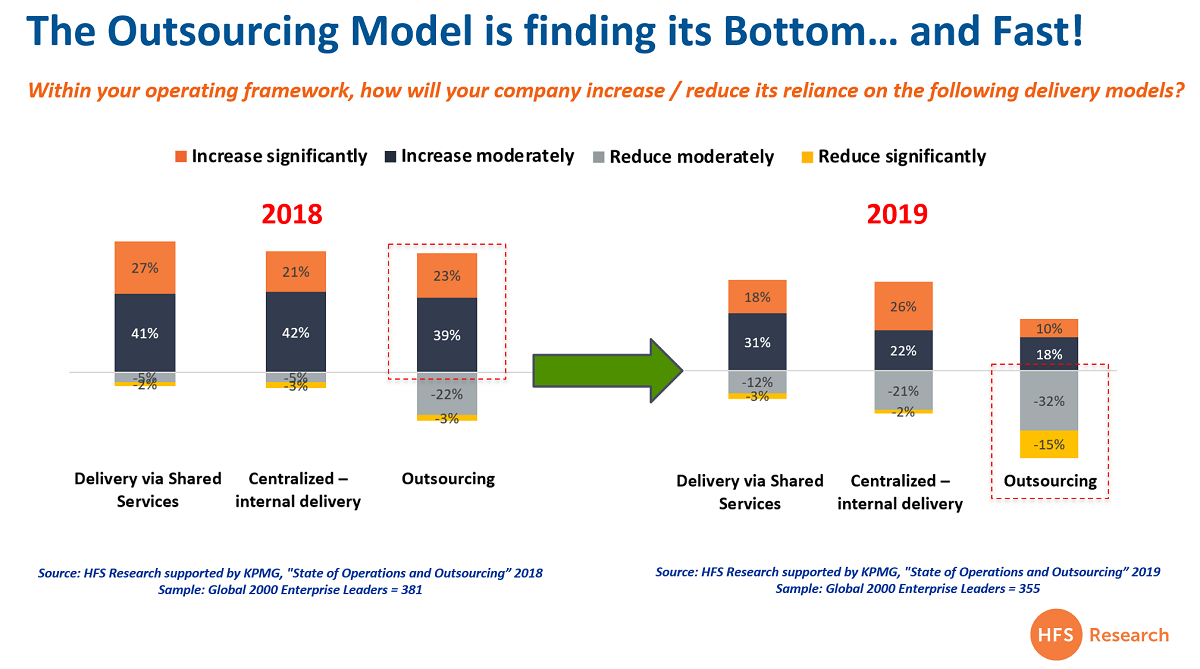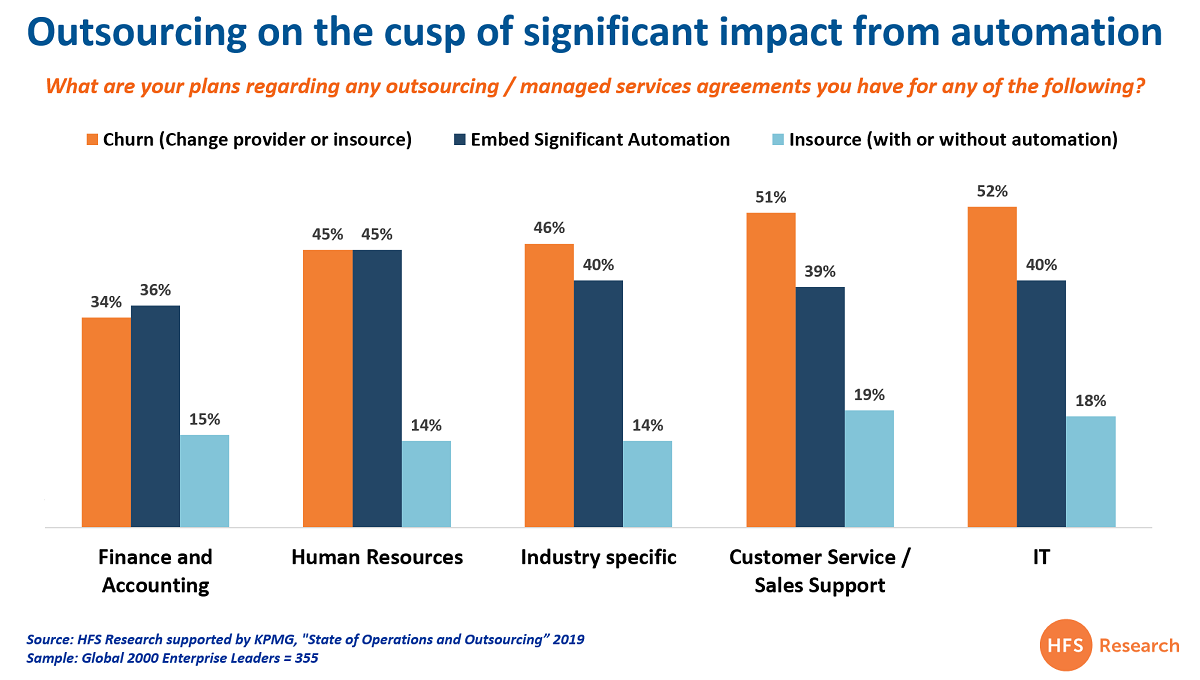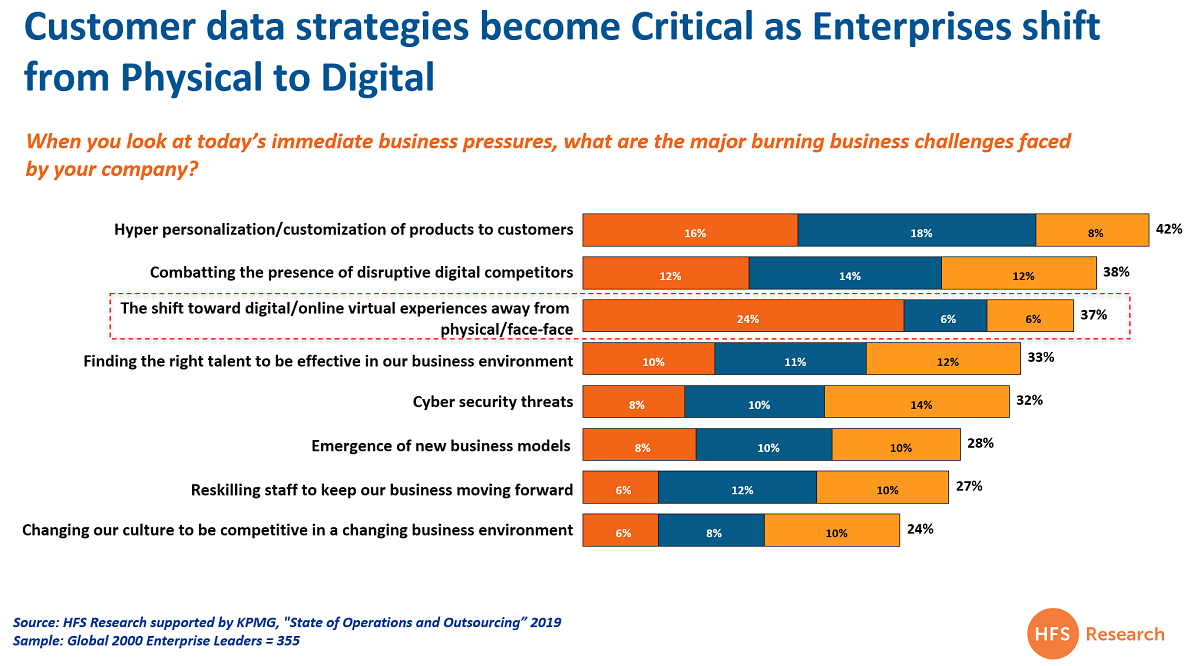It’s taken more than 12 years – ever since the first-ever blog post written right here – but the outsourcing marketing is on the cusp of its most seismic change since the offshore revolution… the majority of enterprises are seeking to pull away from their stale outsourcing relationships and replace people with intelligent cognitive workers which learn context – or simply bots that perform transactional tasks. And the reality of outsourcing is that it’s far easier for an enterprise to eliminate workers that are contracted via a service partner than have to go through all the painful change and resistance when trying to eliminate their own staff directly with software investments. What’s more, enterprises rarely want to bring outsourced work back inhouse until it has been fully automated and the outsourcing offers little future value.
All the lovely fluff about “automation and AI creating jobs” is being proved to be utter claptrap for the services industry when we look at fresh new data from the 2019 State of Operations and Outsourcing Study across 355 operations leaders in the Global 2000, conducted with the support of KPMG:
What’s shocking here is the degree of change in mindset from operations leaders since a year ago, where 62% were still pretty gung-ho positive about investing in their outsourcing model, which has nose-dived to only 28% this year, and a startling 47% actually seeking to decrease their reliance on outsourcing. So if they’re looking at new models to deliver their business operations – and traditional outsourcing no longer fits the bill – what are they looking to do? Let’s take a deeper look:
In short, up to half of major enterprises are looking to find another provider to break their years of painful status quo, while a similar number are looking to embed significant automation into their current engagement. About one-in-six are looking to pull the whole lot back in house and have given up on the delivery model.
Why this change to outsourcing… and why now?
When we look at our reliance on staff to run our operations, we’re seen a substantial reduction over the last couple of decades, mainly due to advances in software applications that embraced process standards (and natively automation). For example, most G2000 enterprises had hundreds of people running finance processes a decade-plus ago, and likely barely have 50-100 based on advances in financial software, combined with efficient outsourcing labor arbitrage models delivered by the likes of Accenture, Genpact, Capgemini, and WNS. Procurement probably had 150 and today barely needs 30… and HR is down to its barebones across most large enterprises. The division most affected by outsourcing – IT – has shrunk from the thousands to the hundreds in most major enterprises over the past two decades. Net-net we’ve been through a very long, sustained period of labor osmosis from enterprises to outsourcers, while shared service functions have stayed largely static.
At the same time, people-driven outsourcing engagements have continued to deliver similar process work back to its enterprise clients with the same number of staff, where the outsourcers have had little incentives to make investments in automation and digital technologies, unless they can directly benefit financially, or have contractually agreed to reduce staff numbers over the course of a long term contract. We are already witnessing the likes of Automation Anywhere, UiPath and AntWorks making significant investments in their own implementation staff as they are frustrated with their lack of traction many outsourcers to incorporate automation and AI technology into the people-focused delivery models.
The new solution is to bypass staff-intensive processes and go “straight to digital”
The big change we are seeing now (and we’ll share more data to back this up shortly) is that the outsourcing models we know and love have long reached their saturation points, and the only real value enterprises can get from them (in the near future) is to remove the number of staff delivering the work and replace them with digital technology. For example, a bank we spoke to recently that is replacing hundreds of staff whose job it is to create customer appointments with a conversationally-intelligent cognitive worker solution. The savings are massive. However, if the bank had outsourced those workers, the only way to force their service provider to replace them with a digital solution would be to demand it upon contract expiry, or bring it back inhouse and do it themselves.
The key is for software and services providers to develop aggressive adoption programs to create the real “straight to digital” ROI
In recent years, we’ve seen many of these digital models evolve – from simple software apps, to chatbots, RPA tools and now more conversationally-intelligent cognitive workers (such as IPSoft’s Amelia, IBM’s Watson, Automation Anywhere’s IQ Bot, TCS’s partnership with Amazon Connect, HCL’s Lucy and Wipro’s solution of Holmes with Avaamo). However, the earlier models where enterprises were being forced to invest multi-millions upfront just to get a cognitive or RPA solution actually functioning without constant human intervention and training, have failed, with the notable inability of IBM’s Watson solution to reach anything like the heights the firm had promised because the market a) wasn’t ready and b) wasn’t convinced the massive outlay would reap massive rewards. And the high-profile struggles of many RPA solutions to replace people with technology (merely augment processes) threaten the rapid rise of those solutions as investors pile on with unrealistic expectations. So the answer is staring us in the face, and it’s pretty straight forward… the winners in this tough new transition market are those which can guide enterprises to take existing processes and move them straight to digital and remove the layer of people delivering them.
The Bottom-line: The only true ROI which created the traditional outsourcing model is now repeating itself with digital solutions
As much as we can spin wonderful stories about augmenting people and enriching jobs etc., the goal of most Global 2000 enterprises is to maximize profits and the stated goals of C-Suites and Ops leaders are to a) reduce operating costs and b) move away from physical to digital environments:
The industry has spoken and it’s clear where they will invest – in partnerships that can accelerate the move to digital without all the painful and costly steps to get there. And the areas most primed to make this happen are where the staff have already been outsourced and the logical next step is to reduce or eliminate them altogether.
The challenge for outsourcers. Defend the clients you really want to keep and attack ones from competitors to backfill the inevitable losses as the model shifts from people to digital. This means you need to develop programs that get your clients leveraging the benefits of automation and AI quickly by hiring talent to make this happen, and forging deep, mutually-be partnerships with software firms to work with you. As we recently discussed at our Robotic Business Outsourcing Roundtable in London, outsourcers face a stark choice between embracing digital models that require less labor, or fading into insignificance.
The challenge for enterprises. Forcing your service providers to cannibalize your business is not an easy task, but if you are willing to work with them to build real digital models that work and become a showcase client for them, you should find a cooperative (and hopefully) ambitious partner to work with you. If you do not, then look further afield for partners willing to invest in your business. If noone wants to transform your operations your business clearly isn’t very attractive (especially if you got a cheap deal to begin with) so you may well be better off bringing operations back inhouse and digitizing them yourself.
The challenge for advisors. Today’s environment should be gravy for you – I’ve heard from several advisor friends that deal flow is really healthy – and it’s mainly outsourcing renewals demanding digital enablement and less people-centricity. Hence deal amounts are declining and demanding more complex tech skills to enable new solutions. Your problem is going to be finding providers willing to embrace disruptive models and work with thinner margins in the short-medium term for longer-term gain. There are several providers out there willing to be aggressive to “land-grab” deals and increase market share, despite thinner margins and scarcity/cost of tech talent. However, you really need to flesh out the providers prepared to put skin in the game, versus those paying lip service.
End of the day, many of the outsourcing partnerships that got so many of us here are unlikely to be the same ones to take us to the next phase…
Posted in : Artificial Intelligence, Business Process Outsourcing (BPO), Robotic Process Automation









Very nicely explained, but I can’t help wonder how many of these executives understand what is the digital metaphor? Thereby falling behind realizing true benefits from digital as history (referred to outsourcing here) has a tendency to repeat itself?
Finally, we have been saying this for five years now. There will be a one last hurrah ofcourse as the outsourcing industry (especially India) explodes into a hiring frenzy.
Prescient advice and predictions from Phil for all to ponder and act
Absolutely agree with your observation. Many businesses are moving away from outsourcing owing to dependencies on service providers, especially when it comes to business critical activities. I have seen customers attempting to build capabilities inhouse, or creating a captive that would address their IT needs.
Digitisation to remove friction at the point of need and not in a ssc miles away from the client 🙂
In the long run, outsourcing model will always exist, given the labour arbitrage opportunities. What we will see over the next few years will be a shift in value creation by the offshore teams. We will see their roles evolve from supporting operations through performing low value adding activities such as processing back office transactions to maintaining digital operations.
@Rajan — Agree but the “shift in value” needs to be faster than “the next few years”. Clients want to see the shift now… PF
This is a good insightful article. Personally, I’ll be glad to see an end to poorly thought out outsourcing deals relying purely on cheaper offshore clerical/administrative/sales and support labour. You get what you pay for. The future for smart outsourcing must surely be around innovative cloud solutions applied to services that organisations do not necessarily want to develop and maintain themselves. The core vs. non-core challenge is still valid. Then the debate moves from onshore/nearshore/offshore to where can I get the right expertise and the right price with the right safeguards for security, reliability and availability.
Shaul
Completely agree, given that tech is now core to business strategy & driving disruption/differentiation across all industries these roles are being in-sourced…..driving down the value of outsourcing.
Also attracting top talent in bleeding edge technologies is getting much harder for top tier SIs/Outsourcers as they find it difficult to change their own org/salary structures & ways of working.
For those who don’t see this change yet, your article is a great wake-up call to see where the puck is moving – Outsourcing is history. Digital is the future. AI is the new electricity powering every process including the ones that have been outsourced. So its about time to get off the steam engine now….
A very significant new article Phil Fersht. This is sure to start a new highly charged and necessary conversation. Going “straight to digital [workers]” will be the logical (and in some cases the only) answer for many enterprises ready to rethink their outsourced functions and processes.
Nick
Straight to Digital instead of labor arbitrage – great for agility, better jobs and more innovation.
This is exactly where AI platforms like HIRO come into play. Phil Fersht has done a great job in diving deep into the data of the market, we only had the gut feeling that acceleration was coming.
It’s the gig world now. Outsourcing, offshoring, near shoring, etc. It doesn’t matter. You can work from anywhere in the world as long as you contribute value. It’s about People more than all these technologies and strategies. How you get to digital will rely on the people tasked to execute on this. Outsourcing companies can still compete if they build a culture of engineering. AI, ML, Big Data etc. are more hype without the proper engineering needed to make them valuable. But I agree with the article, many of them will adapt successfully or fail.
Thanks Phil. We have been seeing these sign posts
All business’ are just like humans and have a natural cycle of breathing in and out, expansion – contraction, growth – recession, centralize – decentralize, new CEO – shortly thereafter new CFO… Outsourcing, SSC, decentralized delivery are simply a tools to be used by business as it fits the needs of the overall strategy. BTW change partner or insource are 2 vastly different animals.
Phil Fersht the ERP era had similar forecasts but true take up and delivery was slow with multiple failures. I worked with one major oil giant whose mantra was. “ we want to be first to be second after the technologies are proven and improved at the cost of our competitors.” The learning must be “Tread with caution”
@Robert – ERP was all about shoe-horning processes into a software template. BPO emerged as an efficient low-cost option for those processes that cannot fit into the template. Automation tech is essentially the first “manual to digital” tech that can decouple labor from processing. Hence this will not follow the same slow painful ERP era… PF
@Steve – Insourcing becomes an option once the current outsourcing has lost all direction and there are no outsourcing change-up options that suit. In some cases the enterprise may even having it forced on them as their provider no longers wants their unprofitable business. Essentially, legacy engagements that were underpriced, resourced with low quality people, incorporating little technology imagination or process transformation. Why do you think providers like DXC, Conduent and others have been quietly offloading some contracts…
PF
There’s another reality here that is often missed which stumps me despite it being 101. Outsourcers are typically kept away from the underlying systems that drive the processes they execute. They are given access to a piece of glass (Citrix) in many cases and told to replicate the in-house teams, but more efficiently. However, it’s critical to have access to these systems to convert/rewrite those processes to become digital. There are exceptions of course, but it’s true that even perfect in-house IT-and-business collaboration has to deal with tough challenges to become digital disruptors of their processes. Alas, trying to do that when all you are is “Alice”, with only the glass to look at, with not even the ability to step through it. Digital disruption is going on at a rapidly colossal rate across most enterprises and tactical solutions are reaching their breaking point to go much further.
Tend to agree that outsourcing is declining in the traditional sense, my livelihood came from the provision of training outsourcing in the main. My experience over the last five years or so has been that RPA, AI, ML, Digital, Social, Content Curation, Google and Utube have had a significantly negative impact in the traditional learning environment I used to operate in. Significantly fewer requests for RFI/RFPs across the industry as organizations look to inspire a workforce that has hugely differing preferred learning styles F2F/ILT training is not really the preferred learning style of most post millennial’s. Its all well documented but providers need to get a lead on whats coming and reinvent/remodel a commercial market space, to many are trying to restructure their businesses instead of their services Outsourcing needs to change ever faster to maintain its presence in a market place. There are some great providers out there
Phil is 100% correct. However the key is governance. AI and RPA is not an over the counter drug. It is complex. It is not solely labor arbitrage. We need to get out of the functional box. Treat Robots as employees. Have controls and oversight. We need to realign functional responsibility’s and up-skill displaced employees to analyze deep data analytics, creating value added insights to process and procedures. The key is using the analysis to improving working capital.